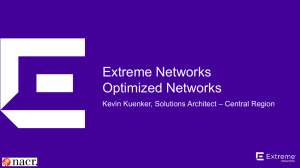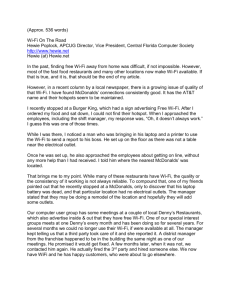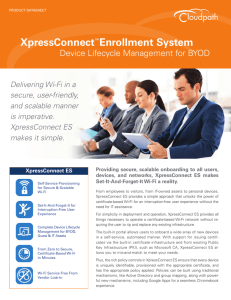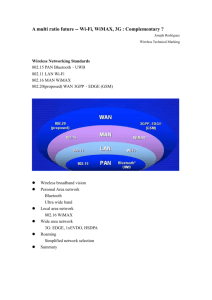The Business and Regulatory Environment for Wi
advertisement
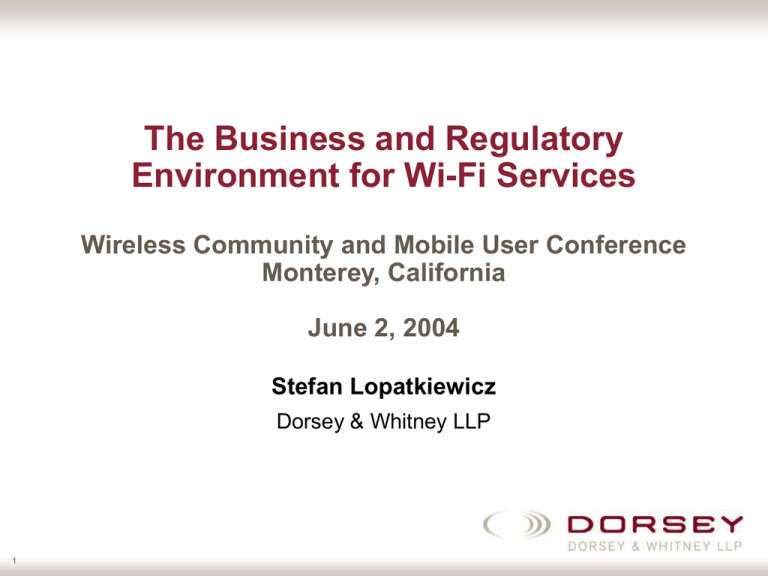
The Business and Regulatory Environment for Wi-Fi Services Wireless Community and Mobile User Conference Monterey, California June 2, 2004 Stefan Lopatkiewicz Dorsey & Whitney LLP 1 What Is “Wi-Fi”? • “Wireless Fidelity”: a trademark for Wireless Local Area Network (WLAN) configuration – Wireless high-speed access to the Internet • Registered by Wi-Fi Alliance – Organization of equipment vendors and service providers interested in the deployment of wireless LAN 2 Visualizing the Fixed Wireless Context Metro Area Network 25 kilometers “Wi-Max” MAN Local Area Network 100 meters “Wi-Fi” LAN PAN 3 Personal Area Network “Bluetooth” 10 meters Wi-Fi and Wireless Ubiquity + = 4 PERSONAL BROADBAND Some Fixed Wireless Historical Background • 1990’s: LMDS (Local Multipoint Distribution Service) Voice, data, video distribution Above 25 GHz range MMDS (Multipoint Multichannel Distribution Service) “Wireless Cable” 2.5/2.7 GHz • Heavy investment by carriers in MMDS (MCI, Sprint, BellSouth) and start-up ventures in LMDS (Teligent, Winstar) • Business plans never materialized Line-of-sight restrictions Heavy debt from spectrum auctions Could not compete with cable, DSL 5 Wi-Fi: The Legal Environment • Technical Standardization • Unlicensed Spectrum 6 ABCs of Technical Standards Spectrum Maximum Bit Rate Maximum Range 802.11b (Wi-Fi) 2.4 GHz 11 Mbps 100 meters Most widely deployed original WLAN standard; good penetration in residential market 802.11a (Wi-Fi) 5.0 GHz 54 Mbps 30 meters Attempted successor to 802.11b because of higher throughput; lower access range limited acceptability 802.11g (Wi-Fi) 2.4 GHz 54 Mbps 100 meters Backward compatible with 802.11b and improved throughput rate; popular successor to 802.11b for enterprise market 802.11i n/a n/a n/a IEEE working group focused on improving WLAN security; produced initial WPA standard in 2003 802.11n 2.4 & 5 GHz 300 Mbps 100 meters Current working group seeks to advance throughput capabilities exponentially 700 Kbps 10 meters Personal area network standard 100 Mbps 25 kilometers Metropolitan area standard; anticipated backhaul solution focuses on non-line-of-sight transmissions 25 kilometers Mobility standard based on 802.16a 802.15 (Bluetooth) 7 802.16a (Wi-Max) 2-11 GHz 802.16e 2-6 GHz 802.20 Below 3.5 GHz Characteristics New Mobility standard for WLAN/WMAN Institute of Electrical and Electronics Engineers (IEEE) • Global private, non-profit industry association – 375,000 individual members – 150 countries • A leading world authority in technical disciplines including information services, telecommunications, electric power, consumer electronics – 1898 – first dedicated efforts toward standardization of electrotechnology in U.S. 8 Structure of IEEE 37 Technical Societies Communications Society Computer Society Board of Directors Executive Committee Executive Director Staff Standards Association 9 IEEE-SA • Membership organization • 12,000 individual members in 107 countries (2003) • 41 corporate members in 11 countries – vendors seek to advance/protect own interests Broadcom Deutsche Telekom IBM Intel Lucent Microsoft Mitel Networks SBC Siemens AG Sonera Tata Consultancy Thales Communications 10 Scope of IEEE 802 Standards Committee • Specifications ensure – the highly reliable delivery of data frames – over a variety of physical media • coax, twisted pair, fiber and wireless – distances covered from 10 meters to 10+ kilometers • Data frames may transport any protocol and/or information within certain size limits 11 802 Standards Committee Organization 802 Architecture Wireline Wireless Advisory 802.1 Bridging 802.3 Ethernet 802.11 WLAN 802.18 Regulatory 802.17 Resilient Packet Ring 802.15 WPAN 802.19 Coexistence 802.16 WMAN 802.20 Mobile BWA 12 IEEE Standardization Process A world-respected technical consensus process Standard Sponsor Group Working Group Task Group Study Group Ad Hoc Group Process supported by enterprise/academic sponsors Passage requires 75% or greater approval 13 IEEE-SA Intellectual Property Requirement • IEEE standards may include the known use of patent(s), including patent applications, provided the IEEE receives assurance from the patent holder or applicant with respect to patents essential for compliance with both mandatory and optional portions of the standard. This assurance shall be a letter that is in the form of either (a) A general disclaimer of intention to enforce patent against any person or entity using the patent to comply with the standard or (b) Agreement to license patent without compensation or under reasonable rates, free of any unfair discrimination • This assurance shall apply, at a minimum, from the date of the standard’s approval to the date of the standard’s withdrawal and is irrevocable during that period. Approved by IEEE-SA Standards Board December 2002 14 The 802.11 Project • Launched in 1990 to “develop a Medium Access Control (MAC) and Physical Layer (PHY) specification for wireless connectivity for fixed portable and moving stations within an area.” 1997 – First standard proposed with a throughput capability of 1-2 Mbps 1999 – 802.11b 11 Mbps throughput 802.11a 54 Mbps throughput 2003 – 802.11g 54 Mbps throughput 2003 – Launched 802.11n to increase throughput; results not expected until 2006. 15 Wi-Fi Alliance • Organization of primarily equipment manufacturers originally founded as Wireless Ethernet Compatibility Association. – Certifies interoperability of 802.11 devices – Not to be confused with IEEE 16 Wi-Fi Alliance Membership RELATED CELL COMPUTERS EQUIPMENT PHONES CARRIERS OTHERS Apple Canon Alcatel AT&T Pronto Network Dell Cisco Systems Ericsson NTT Proxim Gateway Fujitsu Motorola SBC Hewlett Packard Intel Nokia Sprint Trapeze Network IBM Microsoft Palm One Samsung Texas Instruments Toshiba 17 Verisign Basic Mechanics of Wi-Fi ROUTER SERVER SWITCH CAT 5 Cable Backhaul Wireless Access Points (Hot Spots) 18 WI-MAX v. Wi-Fi • January 2003, IEEE approved 802.16a Standard – Provides WLAN access over “Metropolitan” radius – 2-11GHz (both licensed and unlicensed bands) • Offers promise of wireless “last mile” backbone – Potential backhaul solution – Presents threat of making Wi-Fi irrelevant? • July 2003, Intel announced it would begin manufacturing chips to support the standard 19 WI-MAX Forum • Seeks to do for 802.16 what Wi-Fi Alliance did for 802.11 • Members show much overlap with Wi-Fi Alliance, including computer manufacturers, related equipment manufacturers • Some start-up equipment and service providers are focusing on WiMax products in place of Wi-Fi, such as Flarion and Navini Networks • 25% are service providers, including several fixed-line carriers 20 The U.S. Tradition of Unlicensed Spectrum • In 1934 Communications Act, FCC established as federal agency responsible for licensing use of radio spectrum • In contrast to most national telecommunications administrators, FCC has long followed a tradition of permitting use of some frequencies on unlicensed basis • Beginning in 1938, FCC created Part 15 of its rules, governing devices operating in designated bands at low power levels that would not cause interference 21 Part 15 Devices • Realm of Part 15 devices has gradually grown – Unintentional radiators – computer peripheral devices – Incidental radiators – automobile engines – Intentional radiators – low power transmitters • Great growth in 1960’s and 1970’s with consumer applications • Examples include television interface devices, baby monitors, garage door openers, microwave ovens, wireless microphones • Cordless phones became single most import application in 1980’s, and in 1997 surpassed wired phones in U.S. productivity 22 ISM, U-PCS and U-NII Bands • Industrial, Scientific and Medical Bands (immunity to interference and low probability of intercept) – 900 MHz – 2.4 - 2.483 GHz – 5.725 – 5.825 GHz • Unlicensed Personal Communications Services (1993 – digital narrowband voice for communication and highspeed data transfer) – 1910 – 1930 MHz – 2390 – 2400 MHz 23 ISM, U-PCS and U-NII Bands (cont’d) • Unlicensed National Information Infrastructure (1997 – short-range, high-speed digital communications) – 5.15 – 5.35 GHz • As popularity and importance of unlicensed devices has grown, pressure has built for higher power levels in higher frequency ranges 24 Importance of “Smart” Radios for Unlicensed Use • Use of unlicensed frequencies is non-exclusive, not protected from interference • Consequently, focus has shifted to technical capabilities of radios operating in these frequencies – Emission standards – Digital modulation controls • FCC has adopted regulation of transmitter in place of regulation of licensee • Philosophical debate growing over “command and control” licensing of spectrum versus “commons” approach 25 Use of Unlicensed Spectrum for Standardized Devices • IEEE – SA has recognized import of unlicensed frequencies for interoperability – 802.11a – 5 GHz (U-NII) – 802.11b – 2.4 GHz (ISM) – 802.11g – 2.4 GHz (ISM) – 802.16 – 2-11 GHz (licensed and unlicensed bands) • Unlicensed does not mean unregulated 26 Spectrum Regulatory Agencies U.S. – Federal Communications Commission National Telecommunications and Information Administration (Commerce) State public utility commissions Int’l – International Telecommunications Union (U.N.) National administrations 27 Growth of Unlicensed Spectrum for WLAN • January 2002, Wi-Fi Alliance (formerly known as WECA), petitioned FCC to allocate additional 255 MHz of spectrum on 5 GH band for unlicensed WLAN applications • January 2003, interagency group, including NTIA, DoD and FCC, in consultation with ITU-R, reached agreement on sharing the requested spectrum without causing undue interference into military systems – Dynamic Frequency Selection – “Listen before talk” – looks for RADAR use of frequency before transmitting, and seeks out clear channels – Transmitter Power Control (TPC) – reduces maximum power when possible to promote more efficient frequency reuse 28 Growth of Unlicensed Spectrum for WLAN (cont’d) • January 2003 inter-agency agreement led to U.S. position advocating 455 MHz for RLAN use at ITU, summer 2003 • July 2003, ITU approved allocation of 455 MHz for RLAN in 5 GHz range – Not necessarily unlicensed; depends on national administration • November 2003, FCC approved Wi-Fi Alliance petition for additional 255 MHz of unlicensed band in 5 GHz range – Harmonized U.S. allocation with international allocation 29 5 GHz Spectrum Available for WLAN 30 ITU (July 2003) 5.150-5.350 MHz 5.470-5.725 MHz U.S. (Pre-ITU) 5.150-5.350 MHz 5.725-5.825 MHz U.S. (Nov 2003) 5.470-5.725 MHz Total U.S. 5.150-5.350 MHz 5.470-5.825 MHz 455 MHz 300 MHz 255 MHz 555 MHz FCC 3650-3700 MHz Rulemaking • April 2004, NPRM proposes permitting wireless broadband use for 3650-3700 MHz band on either licensed or unlicensed basis • Current Fixed Satellite Services (FSS) band • Would require use of “cognitive” (smart) radio devices – “look before talk” – Self-identifying signal – Preserve zone of protection around existing satellite facilities on coasts • Anticipated benefit for WLAN in rural areas – Permit use at higher power levels than normal Part 15 devices • Located in middle of 2.4/5 GHz bands 31 Unlicensed Broadband in Unused TV Channels • May 2004, FCC NPRM to allow unlicensed broadband devices in unused portions (“white spaces”) of broadcast TV spectrum – Below 1 GHz • Propagation characteristics seen beneficial to permit greater service range for WLAN • Need to employ “smart” radios to avoid interference with TV service • Part of effort to transition to digital TV 32 Greater Flexibility in Use of Unlicensed Devices • September 2003, FCC NPRM to permit use of more advanced antenna technologies in 2.4 and 5 GHz unlicensed bands • Permit broader use of spread spectrum devices under part 15 • Modify replacement antenna restrictions • Expressly intended to support manufacturers and users of unlicensed devices for wireless networks, particularly in rural areas 33 FCC Policy Objectives • May 5, 2004, FCC formed inter-bureau wireless broadband access task force to develop policies • FCC asked for comments so that task force can produce recommendations on how to advance deployment of WISPs by October 2004 • At least two objectives identified – Encourage creation of competitive delivery systems to wireline (DSL), cable – Help deploy broadband to rural areas to reduce “digital divide” 34 Congressional Support for WLAN • 2003 Jump Start Broadband Act – Would require FCC to allocate at least 255 MHz in 5 GHz band for unlicensed broadband use – Direct NTIA to establish standards for interference protection for government users • 2003 Spectrum Commons and Digital Dividends Act – Encourages reallocation of 1700-1800 MHz for wireless broadband and payment for relocation of existing users 35 Wi-Fi: The Business Environment 36 Wi-Fi’s Potential Disadvantages • Limited range – typically up to 100 feet and transmission rates can be slowed by physical obstructions, like walls • Because unlicensed, risk of interference from multiplesource users • Security concerns – how to prevent “rogue” users – Accessing confidential databases – Disrupting legitimate users 37 WPA – THE Wi-Fi Alliance Security Solution • Prior to 2003, Wired Equivalent Privacy (WEP) standard was only Wi-Fi security tool available, and required for Wi-Fi Alliance certification – Determined to be flawed • 802.11i Working Group was dedicated to overcome this challenge • Early 2003, consensus reached on new standard, Wi-Fi Protected Access (WPA), an advanced encryption technology • Consensus that problem has been solved • China made an abortive attempt to advance its own WAPI standard 38 Wi-Fi’s Cost / Deployment Advantage • Access points (hotspots, nodes) can be installed for small cost ($120 residential), assuming backhaul • Deployment is rapid; not much infrastructure required • Networking card has declined from $100 to $30 • Wi-Fi chip now commoditized at $10 39 Delivering the Wi-Fi Signal to the End User PC, Laptop Mobile Phone ACCESS POINT Play Station PDA 40 DVD Player Metrics of Wi-Fi Usage Exponential growth; niche wireless market • U.S. users will increase from 4.2 million to 31 million in four years (Gartner Group) – 80% of laptops sold in 2005 will be Wi-Fi enabled by next year (Gartner) • U.S. revenues have tripled in two years to $1 billion (out of $140 billion wireless market) (Instat/Cahner) – 3.5% of total wireless market by 2009 (BCWS/Sensa) – $11.5 billion global market by 2009 (On World) 41 Four Primary Wi-Fi Markets Low Visibility Residential Enterprise / Campus Internet Public “Hot Spot” Private “Hot Spot” High Visibility 42 Wi-Fi Residential Market • In U.S., this has proven early successful Wi-Fi application • Growth will remain strong, doubling to 8% of high-speed residential market this year, i.e., up to 4 million homes (Jupiter Research) • Next stage of growth: linking pc to home entertainment devices (television, DVD player, etc.) – Could accelerate growth of this market • Two visions: the pc versus the Play Station as the “hub” of residential use; Intel v. Sony/Nintendo/Microsoft 43 Wi-Fi Enterprise / College Campus Market • Colleges adopted relatively quickly as low-priced campus communication system, intense need for Internet access • Specific other vertical applications also made early investments – e.g., health care • Enterprise market has held back due to security concerns, although is already 10x more valuable than residential market in terms of revenue • WPA has “solved” these concerns • 50% of Fortune 1000 will have extensive Wi-Fi deployment by end 2005, integrating 802.11g with wireline systems (Gartner) 44 Wi-Fi “Private” Hot Spots Commercial WISP market Hotels – exponential growth in three years (Wayport, STSN, iPass) 1000 U.S. hotels today, 27,000 by 2007 (Pyramid Group) Evolved from lobbies, conference rooms into guest rooms Airports – captive market (e.g., Boingo) Coffee shops – Starbucks (T-Mobile), McDonald’s (Wayport) Asia Pacific has 53% of private hot spots globally A la carte or monthly subscription to provider “Roaming” agreements needed Some facilities have elected offering as no-charge amenity 45 Airport Hot Spots FCC Petition • Industrial Telecommunications Association petition to FCC to preempt airports’ efforts to control tenants’ provision of Wi-Fi services (January 2004) • Airports claim need to avoid “spectrum interference,” but are clearly offering service to public for a fee • Airports’ position impacts not only coffee houses, restaurants, but potentially airlines – Airlines are deploying RFID systems for baggage control using Wi-Fi frequencies • Query whether landlord rights will prevail 46 Wi-Fi “Public” Hot Spots • Municipalities, urban organizations are deploying “Wi-Fi” zones as means of attracting commerce and tourism, spurring redevelopment • Approaches vary broadly, typically involving some combination of government / chamber of commerce / private sector participation • Washington, D.C. – New “Open Park Project” has launched wireless zone to cover entire Mall area, including Capitol • New York – Bryant Park model • Boston, Portland – Wi-Fi in public housing • Intel list of most “unwired” cities 47 Long Beach, California Who: What: When: Where: Why: City + high tech companies High-speed access at no charge May, 2004 Downtown and Airport Wireless Internet Districts Marketing campaign to attract tourists and new businesses Fox, Smolen & Associates Austin, Texas 48 Athens, Georgia Who: What: When: Where: Why: U. of Georgia Wireless LAN w/ 9 sites 2004 24 blocks of downtown Mobile Media Consortium Fox, Smolen & Associates Austin, Texas 49 Athens, Georgia Fox, Smolen & Associates 50 Austin, Texas New Supreme Court Ruling on Municipal Authority • Section 253 of 1996 Telecom Act authorizes FCC to preempt state and local laws “prohibiting … any entity” from providing telecommunications services • FCC denied a petition by Missouri League of Municipalities to preempt state government from denying cities’ ability to provide telecom services • March 2004, Supreme Court upheld this decision: Telecom Act was not intended to reach state regulation of its own political subdivisions • Whether and extent cities and local governments can establish and operate “wireless zones” is governed by state law 51 Community Wireless Access Systems • Spontaneous, voluntary, municipally-based systems comprised of residential and retail users making access points available for public use – SF Wireless – NYC Wireless – Seattle Wireless – Personal Telco Project (Portland) • Ad hoc in structure – to follow no master plan • 2002 survey in Manhattan reflected 30% residential systems were “locked” 52 The Impact on “Private” Hot Spot Market • Global commercial WISPs will generate only $80 million in current year (Gartner) – $28 million in U.S. – Equals Verizon Wireless revenues in 12 Hours • Problems identified – Too expensive – No ubiquitous network coverage – Growth of “public” hot spots • Cometa Networks (Intel / AT&T / IBM joint venture) is withdrawing from the market • Not a stand-alone business, but many bundled and niche applications 53 Rural Wi-Fi Opportunities • End 2003, Alvarion estimates that unlicensed wireless broadband systems are available in over 3000 U.S. cities and towns, with trend toward smaller, rural communities • Fixed operators recognize Wi-Fi as a tool to bring broadband to more remote areas – As Wi-Max certified systems deploy, “last mile” issue of backhaul could be addressed • Even without backhaul for Internet access, community Intranet can be established – Peer-peer bulletin boards and e-mail – Some tribal communities are starting to use this 54 WAS Case Study: Southern California Tribal Digital Village • San Diego County, USA • Project funded and supported by Hewlett Packard The Challenge • Over 7,600 Native American Indians live on reservations in isolated and scattered communities in Southern California, near the Mexican border • Area spans more than 150 miles and takes more 4 hours to visit by car • 18 Native American Indian reservations • 50% unemployment Tribal Digital Village: Areas of Focus • Access to Education – distance learning, including University of California at San Diego • Cultural Preservation – e.g., language preservation and Web link to specialized cultural library • Community Development • Economic Development • Internet Infrastructure Tribal Digital Village Network Using IEEE 802.11b Power Sources and Network Access Points • Flexible, solar and even car batteries • Access points used as community centers Community Bulletin Board • E-mail exchange • Events calendar • Health information • Education and school resources information • Job opportunities Rural Wi-Fi Opportunities • LARIAT – non-profit community wireless network in Laramie, WY • MagnoliaRoad.net – rural Wi-Fi coop in Colorado • BRAIN – Broadband Rural Access Information Network – Public/private partnership between regional WISP and school districts in western PA – Access points installed at schools • Free use at schools • Residential users pay for access • E-rate funding is helping subsidize – Now expanding into western MD – Applying to Dept. Agriculture / RUS for broadband grants and loans 61 Voice Applications of Wi-Fi • Delivery of narrowband voice signal via Wi-Fi is a growing application – Dartmouth, U. of Arkansas systems – Laptops, PDAs become “softphones” – Substantial cost savings to institutions • Hospitals use as push-to-talk • Commercial VOIP applications now being offered – IDT system in Newark, NJ using Net2Phone handsets and LMDS spectrum for backhaul 62 Wi-Fi / Wi-Max – Mobile Complement or Competitor • Mobile operators hope to offer broadband in 2.5G and 3G models – UMTs promised in Europe by end of year • Wi-Fi greater throughput poses challenge – Nokia and Motorola both rolling out “hybrid” Wi-Fi capable handsets in 2004 – 85% mobile handsets will be Wi-Fi capable by 2010 (On World) • Wi-Max starting to blur the lines between portability and mobility – 802.16 is attracting carriers for fixed opportunities – 802.20 is viewed with some hostility because it is looking to full mobility 63 RFID – A New Wi-Fi Driver • Radio Frequency Identification – Inventory and asset control – Security – Industrial tracking • 2004-05 anticipated to be breakthrough year • Wal-mart requiring 100 top suppliers to have pallets and cases tagged by January 2005 • Homeland security application? • Privacy concerns? 64 The Policy Perspective of Wi-Fi • Should wireless access to the Internet be free to the public? – Is it our latest form of highways, bridges? • Industrial applications indicate there will be a commercial role • Should also be an ancillary commercial service for mobile carriers, DSL 65 STEFAN M. LOPATKIEWICZ Dorsey & Whitney LLP Suite 400 South 1001 Pennsylvania Avenue NW Washington, DC 20004-2533 Phone: (202) 442-3553 Fax: (202) 442-3199 lopatkiewicz.stefan@dorsey.com 66

